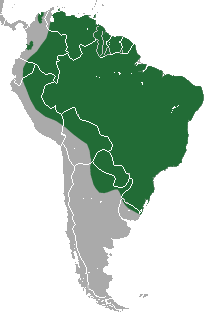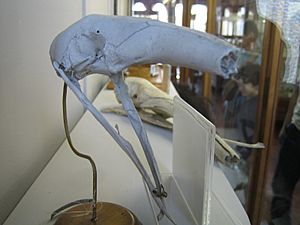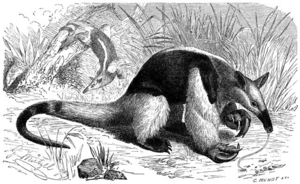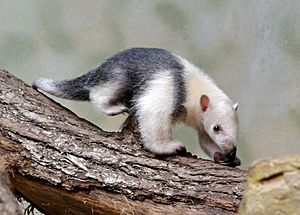Collared anteater facts for kids
Quick facts for kids Southern tamandua |
|
|---|---|
 |
|
| In defensive posture | |
| Conservation status | |
| Scientific classification | |
| Genus: |
Tamandua
|
| Species: |
tetradactyla
|
 |
|
| Southern tamandua range | |
| Synonyms | |
|
Myrmecophaga tetradactyla Linnaeus, 1758 |
|
The southern tamandua (Tamandua tetradactyla), also called the collared anteater or lesser anteater, is a type of anteater. It lives in South America and on the island of Trinidad in the Caribbean.
This animal lives alone and can be found in many different places. These include old forests, newer forests that have been disturbed, and dry grasslands. Southern tamanduas eat ants, termites, and bees. They have very strong front claws. They use these claws to break open insect nests or to protect themselves from danger.
Contents
Where They Live and Their Home
The southern tamandua lives in Trinidad and across South America. You can find them from Venezuela down to northern Argentina, southern Brazil, and Uruguay. They live in places up to 1,600 meters (about 5,250 feet) high.
They make their homes in both wet and dry forests. This includes tropical rainforests, savannas (grasslands), and thorn scrub areas. They seem to be most common near streams and rivers. These areas often have many vines and epiphytes (plants that grow on other plants). This is probably because their food is easy to find there.
The oldest known fossils of tamanduas are from the Pleistocene epoch. This was a long time ago, during the Ice Age. Genetic studies suggest they might have split from their closest relative, the giant anteater, even earlier. This could have been about 12.9 million years ago.
Types of Southern Tamanduas
There are four known types, or subspecies, of Tamandua tetradactyla:
- T. t. tetradactyla (Linnaeus, 1758): Found in southern and eastern Brazil, and Uruguay.
- T. t. nigra (Geoffroy, 1803): Found in northern Brazil, Colombia, Venezuela, Trinidad, and the Guianas.
- T. t. quichua (Thomas, 1927): Found in Peru, Ecuador, and the far western part of Brazil.
- T. t. straminea (Cope, 1889): Found in southern Brazil, Paraguay, Bolivia, and Argentina.
What They Look Like
The southern tamandua is a medium-sized anteater. Its size can change a lot depending on where it lives. Their head and body are usually between 34 to 88 centimeters (about 13 to 35 inches) long. Their tail, which can grip things, is 37 to 67 centimeters (about 15 to 26 inches) long.
Adults weigh from 1.5 to 8.4 kilograms (about 3.3 to 18.5 pounds). Males and females are about the same size. Like their close relative, the northern tamandua, they have four claws on their front feet. They have five claws on their back feet. They walk on the outside edges of their front feet. This keeps their sharp claws from poking their palms. The underside and the tip of their tail have no hair.
Their snout is long and curved downwards. The opening of the snout is very small, only as wide as a stick. Their tongue comes out of this small opening. Southern tamanduas can be told apart from northern tamanduas by their slightly longer ears. Their ears are about 5 centimeters (2 inches) long, while northern tamanduas have ears about 4 centimeters (1.6 inches) long.
The color and markings of southern tamanduas can vary a lot. This has made it hard for scientists to describe them. Animals from the southeastern part of their range often have strong black markings. These markings go from their shoulders to their rump. The black patch gets wider near the shoulders and goes around their front legs. The rest of their body can be blonde, tan, or brown.
Animals from northern Brazil and Venezuela to west of the Andes mountains are often solid blonde, brown, or black. Some might have very light markings. Tamanduas from Trinidad are almost always solid blonde.
How They Have Babies
Female tamanduas can have babies more than once a year. Mating usually happens in the fall. The female's cycle lasts about 42 days. Pregnancy lasts from 130 to 190 days. The female gives birth to one baby each year.
When a baby anteater is born, its fur does not look like its parents' fur. Its coat can be white to black. The baby rides on its mother's back for several months, sometimes up to a year. The mother might leave the baby on a safe tree branch while she looks for food.
Their Behavior
Southern tamanduas are mostly active at night, but sometimes they are active during the day. They make their nests in hollow tree trunks. They also use burrows dug by other animals, like armadillos. They live alone and have their own areas, called home ranges. These ranges are usually between 100 to 375 hectares (about 250 to 927 acres). The size depends on the local environment.
When they are annoyed, they might hiss. They can also release a bad smell from special glands near their tail. They spend a lot of their time looking for food in trees. One study in Venezuela showed that these anteaters spend 13% to 64% of their time in trees.
The southern tamandua is quite clumsy on the ground. It walks slowly and cannot gallop like its relative, the giant anteater.
The southern tamandua uses its strong front arms to defend itself. If it feels threatened in a tree, it will grab a branch with its back feet and tail. This leaves its arms and long, curved claws free to fight. If attacked on the ground, the anteater will back up against a rock or a tree. Then it will grab its attacker with its front arms.
In the rainforest, southern tamanduas are often surrounded by flies and mosquitoes during the day. They are often seen wiping these insects from their eyes. These animals have small eyes and cannot see very well. But their large, upright ears mean that hearing is very important for them.
What They Eat
Southern tamanduas eat about the same amount of ants and termites. They might also eat a small amount of fruit. They find their food by smell. They eat many different kinds of insects. These include army ants, carpenter ants, and Nasutitermes termites. They usually avoid eating ants that have strong chemical defenses, like leafcutter ants.
They also eat beetle larvae (baby beetles). They get the water they need from their food. Like with ants, they generally avoid beetles that have a chemical defense. People also think tamanduas eat honey and bees. In zoos, they have been known to eat fruit and meat.
Anteaters get their prey by using their very strong front limbs to rip open nests. Then they use their long snouts and round tongues, which can be up to 40 centimeters (about 16 inches) long, to lick up the insects.
Even though they eat the same things as the giant anteater, both animals can live in the same areas. This might be because the southern tamandua can reach nests in trees, while the larger giant anteater cannot.
Keeping Them Safe
The southern tamandua is listed under CITES Appendix II in southeastern Brazil. This means that trade of these animals is controlled to protect them. Even though they are found in many places, they are not very common.
Hunters sometimes kill them because they believe tamanduas kill dogs. They are also killed for the thick tendons in their tails, which are used to make rope. Sometimes, people in the Amazon use tamanduas to get rid of ants and termites in their homes.
See also
 In Spanish: Oso melero para niños
In Spanish: Oso melero para niños





